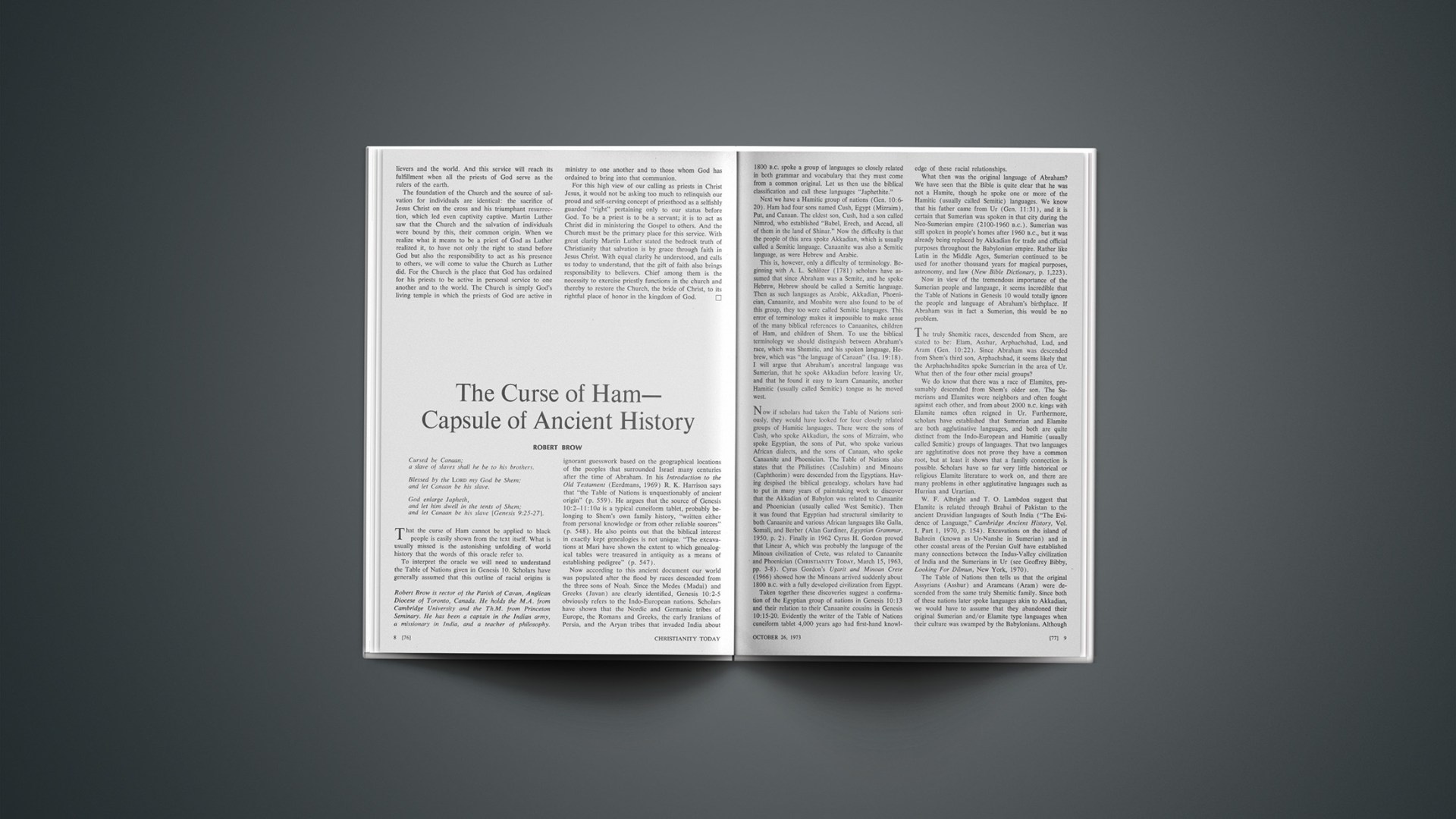Cursed be Canaan;
a slave of slaves shall he be to his brothers.
Blessed by theLORDmy God be Shem;
and let Canaan be his slave.
God enlarge Japheth,
and let him dwell in the tents of Shem;
and let Canaan be his slave [Genesis 9:25–27].
That the curse of Ham cannot be applied to black people is easily shown from the text itself. What is usually missed is the astonishing unfolding of world history that the words of this oracle refer to.
To interpret the oracle we will need to understand the Table of Nations given in Genesis 10. Scholars have generally assumed that this outline of racial origins is ignorant guesswork based on the geographical locations of the peoples that surrounded Israel many centuries after the time of Abraham. In his Introduction to the Old Testament (Eerdmans, 1969) R. K. Harrison says that “the Table of Nations is unquestionably of ancient origin” (p. 559). He argues that the source of Genesis 10:2–11:10a is a typical cuneiform tablet, probably belonging to Shem’s own family history, “written either from personal knowledge or from other reliable sources” (p. 548). He also points out that the biblical interest in exactly kept genealogies is not unique. “The excavations at Mari have shown the extent to which genealogical tables were treasured in antiquity as a means of establishing pedigree” (p. 547).
Now according to this ancient document our world was populated after the flood by races descended from the three sons of Noah. Since the Medes (Madai) and Greeks (Javan) are clearly identified, Genesis 10:2–5 obviously refers to the Indo-European nations. Scholars have shown that the Nordic and Germanic tribes of Europe, the Romans and Greeks, the early Iranians of Persia, and the Aryan tribes that invaded India about 1800 B.C. spoke a group of languages so closely related in both grammar and vocabulary that they must come from a common original. Let us then use the biblical classification and call these languages “Japhethite.”
Next we have a Hamitic group of nations (Gen. 10:6–20). Ham had four sons named Cush, Egypt (Mizraim), Put, and Canaan. The eldest son, Cush, had a son called Nimrod, who established “Babel, Erech, and Accad, all of them in the land of Shinar.” Now the difficulty is that the people of this area spoke Akkadian, which is usually called a Semitic language. Canaanite was also a Semitic language, as were Hebrew and Arabic.
This is, however, only a difficulty of terminology. Beginning with A. L. Schlözer (1781) scholars have assumed that since Abraham was a Semite, and he spoke Hebrew, Hebrew should be called a Semitic language. Then as such languages as Arabic, Akkadian, Phoenician, Canaanite, and Moabite were also found to be of this group, they too were called Semitic languages. This error of terminology makes it impossible to make sense of the many biblical references to Canaanites, children of Ham, and children of Shem. To use the biblical terminology we should distinguish between Abraham’s race, which was Shemitic, and his spoken language, Hebrew, which was “the language of Canaan” (Isa. 19:18). I will argue that Abraham’s ancestral language was Sumerian, that he spoke Akkadian before leaving Ur, and that he found it easy to learn Canaanite, another Hamitic (usually called Semitic) tongue as he moved west.
Now if scholars had taken the Table of Nations seriously, they would have looked for four closely related groups of Hamitic languages. There were the sons of Cush, who spoke Akkadian, the sons of Mizraim, who spoke Egyptian, the sons of Put, who spoke various African dialects, and the sons of Canaan, who spoke Canaanite and Phoenician. The Table of Nations also states that the Philistines (Casluhim) and Minoans (Caphthorim) were descended from the Egyptians. Having despised the biblical genealogy, scholars have had to put in many years of painstaking work to discover that the Akkadian of Babylon was related to Canaanite and Phoenician (usually called West Semitic). Then it was found that Egyptian had structural similarity to both Canaanite and various African languages like Galla, Somali, and Berber (Alan Gardiner, Egyptian Grammar, 1950, p. 2). Finally in 1962 Cyrus H. Gordon proved that Linear A, which was probably the language of the Minoan civilization of Crete, was related to Canaanite and Phoenician (CHRISTIANITY TODAY, March 15, 1963, pp. 3–8). Cyrus Gordon’s Ugarit and Minoan Crete (1966) showed how the Minoans arrived suddenly about 1800 B.C. with a fully developed civilization from Egypt.
Taken together these discoveries suggest a confirmation of the Egyptian group of nations in Genesis 10:13 and their relation to their Canaanite cousins in Genesis 10:15–20. Evidently the writer of the Table of Nations cuneiform tablet 4,000 years ago had first-hand knowledge of these racial relationships.
What then was the original language of Abraham? We have seen that the Bible is quite clear that he was not a Hamite, though he spoke one or more of the Hamitic (usually called Semitic) languages. We know that his father came from Ur (Gen. 11:31), and it is certain that Sumerian was spoken in that city during the Neo-Sumerian empire (2100–1960 B.C.). Sumerian was still spoken in people’s homes after 1960 B.C., but it was already being replaced by Akkadian for trade and official purposes throughout the Babylonian empire. Rather like Latin in the Middle Ages, Sumerian continued to be used for another thousand years for magical purposes, astronomy, and law (New Bible Dictionary, p. 1,223).
Now in view of the tremendous importance of the Sumerian people and language, it seems incredible that the Table of Nations in Genesis 10 would totally ignore the people and language of Abraham’s birthplace. If Abraham was in fact a Sumerian, this would be no problem.
The truly Shemitic races, descended from Shem, are stated to be: Elam, Asshur, Arphachshad, Lud, and Aram (Gen. 10:22). Since Abraham was descended from Shem’s third son, Arphachshad, it seems likely that the Arphachshadites spoke Sumerian in the area of Ur. What then of the four other racial groups?
We do know that there was a race of Elamites, presumably descended from Shem’s older son. The Sumerians and Elamites were neighbors and often fought against each other, and from about 2000 B.C. kings with Elamite names often reigned in Ur. Furthermore, scholars have established that Sumerian and Elamite are both agglutinative languages, and both are quite distinct from the Indo-European and Hamitic (usually called Semitic) groups of languages. That two languages are agglutinative does not prove they have a common root, but at least it shows that a family connection is possible. Scholars have so far very little historical or religious Elamite literature to work on, and there are many problems in other agglutinative languages such as Hurrian and Urartian.
W. F. Albright and T. O. Lambdon suggest that Elamite is related through Brahui of Pakistan to the ancient Dravidian languages of South India (“The Evidence of Language,” Cambridge Ancient History, Vol. I, Part 1, 1970, p. 154). Excavations on the island of Bahrein (known as Ur-Nanshe in Sumerian) and in other coastal areas of the Persian Gulf have established many connections between the Indus-Valley civilization of India and the Sumerians in Ur (see Geoffrey Bibby, Looking For Dilmun, New York, 1970).
The Table of Nations then tells us that the original Assyrians (Asshur) and Arameans (Aram) were descended from the same truly Shemitic family. Since both of these nations later spoke languages akin to Akkadian, we would have to assume that they abandoned their original Sumerian and/or Elamite type languages when their culture was swamped by the Babylonians. Although archaeologists have so far ignored this clue, they would be wise to take the Table of Nations seriously, and at least consider this racial connection. Even Amos, a thousand years later, still knew that the Arameans originally came from Kir (Amos 9:7), and Isaiah links Kir with Elam (Isaiah 22:6). Another son of Shem was Lud, who might be the ancestor of the ancient kings of Lydia in Asia Minor.
As can be seen from a Bible atlas, we should imagine the sons of Shem stretching at one time from Asia Minor, through the mountains to the north of the Tigris, to Sumerian Ur, the Persian Gulf, and across into North India. If these people were all viewed as one language group, of which Elamite only remained as a spoken language, we can understand the significance of the famous inscriptions of Darius and Xerxes. These were written in three languages, Old Persian representing the Japhethites, Elamite for the Shemites, and Akkadian from the Hamitic group of languages.
If Abraham was a Shemite by race who spoke Sumerian as his family language in Ur, we can picture the situation as the Neo-Sumerian civilization ended in 1960 B.C. Already Terah and his sons would be speaking Akkadian, and looking west to Babylon and beyond. We can understand why the family settled among the Arameans of Haran, since these were blood-brothers who probably still spoke their ancestral language but were already being assimilated into Hamitic culture.
Abraham himself pushed on south by God’s command into Canaanite, and therefore potentially hostile Hamitic, territory. The language would, however, be no problem to him, since it was closely related to the Akkadian dialects of the Babylonian empire. There was the obvious temptation for Abraham and his children to merge by marriage with the Hamitic population. Ishmael’s mother and wife were both Egyptian. Abraham insisted that his servant travel back to Haran to find a Shemitic wife for Isaac. Whereas Esau contented himself with two local girls, Jacob went and served fourteen years for Leah and Rachel from his own race. All this and much else becomes clear if we stick to the biblical terminology and call Abraham a Shemite, but avoid the term Semitic for the Akkadian and Canaanite peoples among whom he lived.
Now, armed with the exact terminology of the Table of Nations, we can grasp the tremendous significance of the curse of Ham with which this study began. The curse is clearly limited to the descendants of Ham’s fourth son, Canaan. The children of Canaan included Amorites, Girgashites, Jebusites, etc. of the promised land, plus the Sidonians who were the Canaanites of Phoenicia (Gen. 10:15–19). Our text refers to three different movements that disastrously affected this group of Canaanite nations.
The first sentence tells us that the descendants of Canaan were to be enslaved by brother Hamites. This in fact kept on happening over a period of a thousand years. In the fifteenth century B.C. Canaanite states were under the domination of Egypt. From 841 B.C. for about the next two centuries the Canaanites of Phoenicia were repeatedly dominated by Akkadian kings, who had occupied the territory called Assyria. Later, as prophesied by both Jeremiah and Ezekiel, the Phoenicians came under the Akkadians from Babylonia (see New Bible Dictionary under Tyre, pp. 1302–1303).
Secondly, in our text we are told that the Canaanites were to be enslaved by the descendants of Shem. This was fulfilled when Abraham’s descendants, who had kept their Shemitic identity, multiplied in Egypt and came back to defeat Og and Sihon, Amorite kings of Transjordan, and then overcame the Canaanite tribes west of the Jordan under Joshua.
In the third part of Noah’s prophecy it is stated that the Canaanites are also to be enslaved by Japhethites, or Indo-Europeans. This took place when the people of Tyre and Sidon, who were the only Canaanites who still retained a national identity, were subjugated by Greeks under Alexander the Great. This still left the expatriate Canaanites of the Phoenician colonies, who fought so valiantly against the Japhethite Romans in the Punic wars until the destruction of Carthage in 146 B.C. This date would then mark the completion of the curse of Ham on the Canaanites, who had ceased to be a nation by New Testament times.
Obviously this astonishing prophecy has nothing to do with the black peoples of today. Whether the races of Africa were descended from Mizraim, or from Put, or from a mixture of Shemites and Hamites, they are definitely not classed as Canaanites, and so cannot be under the curse of Ham.
Finally, we note that in the third section of the prophecy Japhethites are to be “enlarged,” and they will occupy Shemitic territory. By about 1800 B.C. invading Indo-Europeans had taken over Asia Minor and overthrown the ancient Shemitic kingdom of Lydia. The great Hittite empire was definitely Indo-European, and it ruled over large areas of what had been Shemitic territory. Later the Medes and Persians occupied the territory of the Shemitic Elamites. If the Indus-Valley civilization of India was racially the same as the Sumerians, then they also would have been Shemites who were ousted by invading Japhethite Aryans about 1800 B.C. In any case, according to Noah’s prophecy the movement of Japhethite peoples into “the tents of Shem” was taking place on a massive scale in the Old Testament period. Eventually, of course, the children of Japheth “enlarged” into Europe and across into North America.
The so-called curse of Ham should be retrieved from crankish misuse by racists. It is in fact a capsule prophecy that sums up vast movements of ancient history. It makes clear that God is in control of the empires of men. Most Old Testament scholars have dismissed Genesis 9 and 10 as garbled myths that cannot be taken seriously. That is no longer an honest attitude. The Almighty did not intend us to be ignorant concerning our early ancestry.










